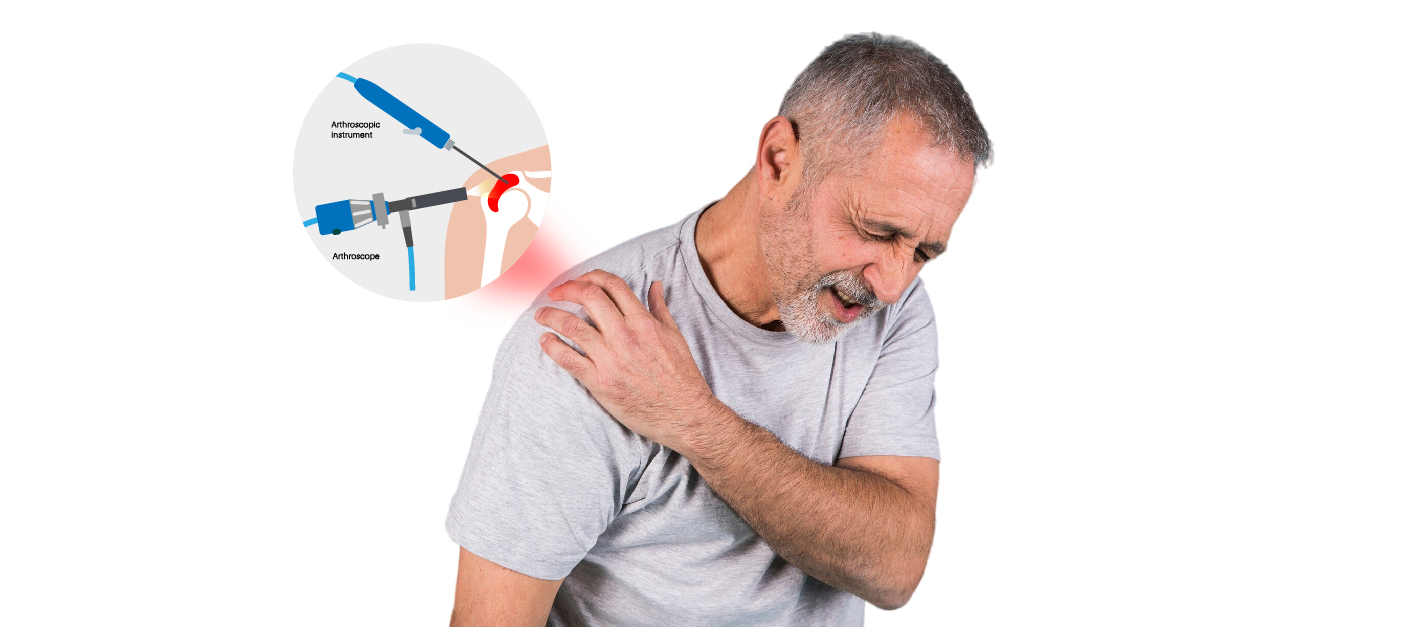
Shoulder arthroscopy is a minimally invasive surgical procedure used to visualize, diagnose and treat shoulder problems. It is the second most orthopedic surgery performed after knee arthroscopy. Shoulder impingement and rotator cuff injuries are often managed with shoulder arthroscopy. Rotator cuff surgery is a common type of shoulder arthroscopy.
During the shoulder arthroscopy procedure, your doctor will insert a tiny camera (arthroscope) into your shoulder joint through the tiny incisions made in the shoulder joint. This tiny camera displays the inner structures in a connected video screen and the surgeon used these images to locate the source of injury and to guide the instruments. As it is a minimally invasive procedure, a small incision is only needed for the procedure which makes less postoperative pain for the patient.
Shoulder arthroscopy is an outpatient procedure that lets patients go home on the same day. However complete recovery may take a few weeks to months. Medication, physiotherapy, and exercises will help to speed up the healing process.
Shoulder arthroscopy is a minimally invasive procedure that helps healthcare providers to detect, diagnose, and treat shoulder problems. Your doctor will recommend you undergo shoulder arthroscopy only if your shoulder pain and associated difficulties are not controlled with the use of medications, physical therapy, proper rest, and injections.
Following are the conditions in which your doctor may recommend you to undergo shoulder arthroscopy:
Before shoulder arthroscopy, your doctor will have a detailed discussion with you regarding the symptoms you are experiencing, do you have any other medical conditions, and which medications you are taking currently. After the discussion, they will make a physical examination. Along with this, your doctor will ask you to perform certain diagnostic tests like X-rays, blood tests, and ECG to assess your health status. Shoulder arthroscopy usually takes less than an hour to complete.
The following are the steps carried out in shoulder arthroscopy:
Shoulder arthroscopy is an outpatient procedure and it takes nearly an hour to complete it. You can go home on the same day. You will need to be in the hospital for 1-2 hours after surgery to recover. Your surgeon will give medications to control pain if needed.
Compared to other open surgeries which require larger incisions, shoulder arthroscopy is a minimally invasive procedure that needs tiny incisions to complete the procedure. This will help to reduce post-operative pain and to speed up the healing process. Shoulder arthroscopy often tends to cause less joint pain and stiffness as compared to other open surgeries.
You may experience pain and swelling around the joint for several weeks and it may take weeks to months for complete healing after shoulder arthroscopy. Taking pain-relieving medicines and applying ice packs will help you to reduce the pain. Your doctor may advise you to put your hands in a sling to protect your shoulder.
The shoulder arthroscopy rehabilitation plan includes gentle exercise and physical therapy to control pain and improve joint movements. Complete recovery depends upon the complexity of the surgery you had. Ask your doctor in detail about the things to be carried out for a faster recovery.
The following are the common arthroscopic procedures:
The cost for shoulder arthroscopy varies for different people according to the complexity of surgery done, hospital chosen for surgery, surgeon’s fee, duration of hospital stay, medicines and other laboratory charges, overall health of the patient as well as the insurance coverage the patient has.
Shoulder arthroscopy is a minimally invasive procedure that helps to treat shoulder problems including shoulder impingements and rotator cuff tears. The procedure needs very minimal incisions and a shorter duration about 1 hour to complete it. You can go home on the same day after shoulder arthroscopy, but the complete recovery may take several weeks to months. Exercise and physical therapy help to speed up the healing process. Discuss in detail with your doctor regarding the rehabilitation plans after shoulder arthroscopy to promote faster healing.
Experience personalized care in joint restoration from Dr ISHWAR Bohra, a senior orthopedic surgeon in Delhi. Book your consultation today.
Q: Is shoulder arthroscopy a major surgical procedure?
A: Shoulder arthroscopy is a minimally invasive procedure that helps to manage shoulder problems including shoulder impingements and rotator cuff tears. It takes about an hour to complete the procedure.
Q: What is the success rate of shoulder arthroscopy?
A: Shoulder arthroscopy is a safer procedure and about 90% of people experience pain relief and stiffness relief after the procedure. It may take weeks to several months for a complete recovery.
Q: Is a shoulder arthroscopy painful?
A: Shoulder arthroscopy can cause some pain and discomfort, especially in the first few days after surgery. Pain management and physical therapy are essential to help alleviate pain and aid in recovery.
Staying abreast with the latest information is the best way to combat diseases in early stages and live a healthy life. Read the latest news & updates here to learn about the recent advancements in joint care and therapeutics.


